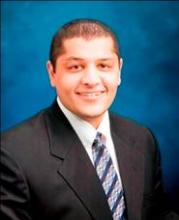PHILADELPHIA – Diabetic lower-extremity wound response to hyperbaric oxygen treatment was unaffected by pretreatment glycemic control in a multicenter, prospective cohort study of 22 adults with lower-extremity ulcers.
The finding suggests that hyperbaric oxygen treatment should not be delayed in patients whose glycemic control is suboptimal at the time that the therapy is prescribed, said Dr. Owaise Mansuri, an endocrinology fellow at Southern Illinois University, Springfield.
Hyperbaric oxygen is increasingly used as an adjunct to antibiotics, debridement, and revascularization for therapy of chronic nonhealing wounds associated with diabetes mellitus. The treatment enhances wound healing pathways including phagocyte function, collagen synthesis, and angiogenesis. Results have been mixed, but studies show increased rates of ulcer healing (Diabetes Care 2003;26:2378-82) and decreased amputation rates (Wound Rep. Regen. 2008;16:513-9). The impact of glycemic control at time of treatment has not been studied, Dr. Mansuri said.
There were 12 patients with hemoglobin A1c values less than 7.5% ("controlled") and 10 with values of 7.5% or above ("uncontrolled"). Other than mean HbA1c (6.5% vs. 8.8%), there were no significant demographic or disease characteristic differences between the two groups.
Patients received 20 hyperbaric oxygen sessions and routine wound care over a 1-month period. No ulcers were superficial; all were Wagner grade 2-4.
Wound volume was reduced by 65% in the controlled group and 71% in the uncontrolled group, a nonsignificant difference. Wound healing also was unaffected by presence or absence of peripheral artery disease, hypertension, tobacco use, weight, duration of diabetes, or ulcer duration, Dr. Mansuri said.
Ulcer area and depth were similarly unaffected by glycemic status, with both groups experiencing an area reduction of 46% and a depth reduction of 47% for the "controlled" group and 48% for the "uncontrolled" patients. Similar numbers of patients from both groups experienced a 50% or greater reduction in ulcer size (4 and 3, respectively).
Asked how to reconcile these findings with those from numerous previous studies suggesting that hyperglycemia delays wound healing, Dr. Mansuri said "We suspect that the effect of hyperbaric oxygen therapy was potent enough to overcome the negative effect of hyperglycemia."
This study was funded by Nevada Idea Network of Biomedical Research Excellence. Dr. Mansuri had no other disclosures.


